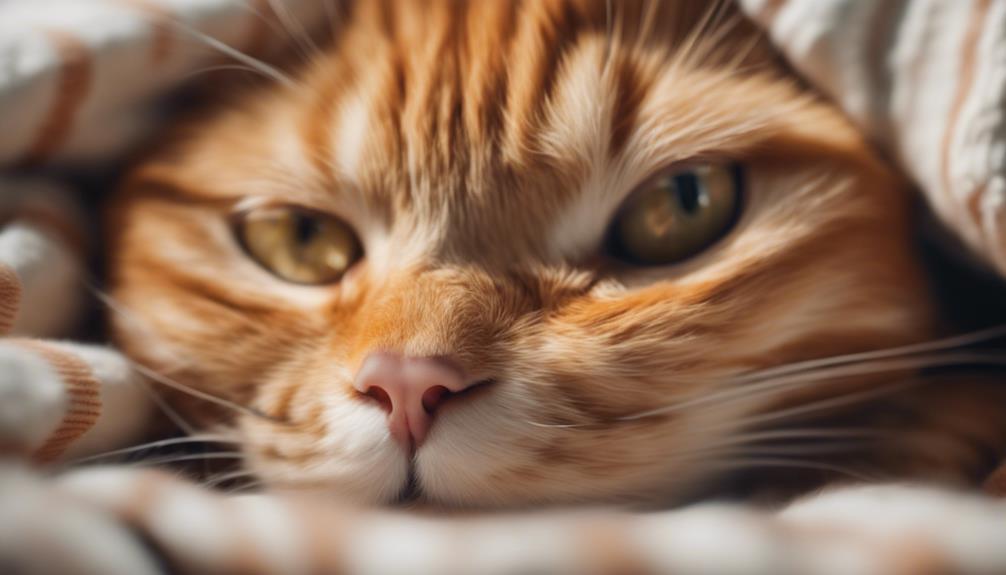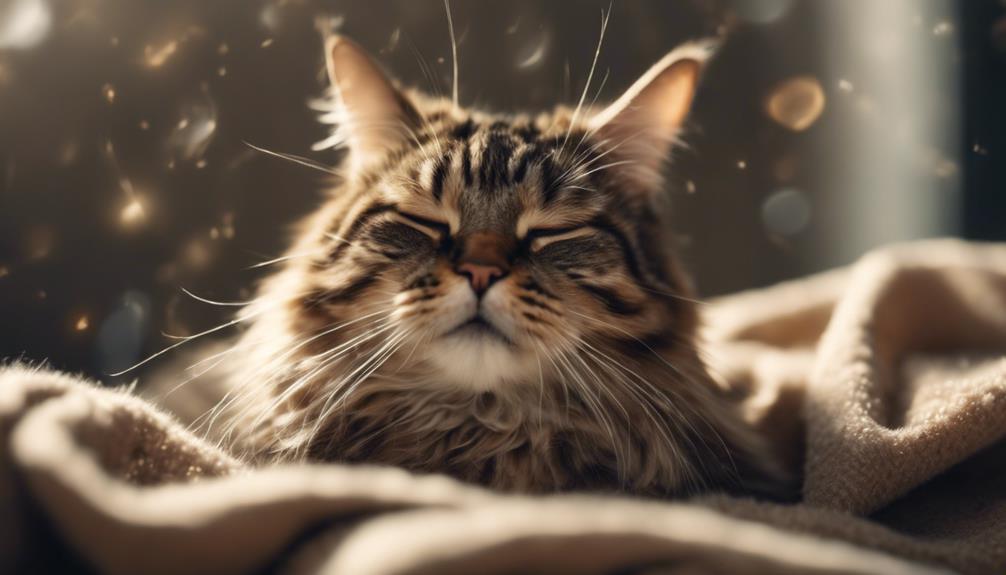Have you ever noticed that nearly 90% of cats exhibit kneading behavior at some point in their lives?
This fascinating feline habit has puzzled cat owners for ages, prompting questions about its origins and significance.
Understanding why cats knead can provide valuable insights into their emotional well-being and innate instincts.
Stay tuned to uncover the intriguing reasons behind this common behavior and discover how it can strengthen the bond between you and your cat.
Key Takeaways
- Cats knead for comfort, safety, and bonding.
- Kneading behavior is reinforced by attention and soft surfaces.
- Kneading allows cats to mark ownership with scent.
- Redirect kneading to a blanket for comfort and training.
Origins of Cat Kneading
Cat kneading behavior, deeply rooted in their instincts, serves as a way for them to express comfort and ownership through rhythmic paw movements. This behavior originates from kittenhood, where kneading helped stimulate milk flow from their mother while providing a sense of safety and comfort.
As cats grow, this behavior evolves into a way to mark their territory and show affection towards their owners. By kneading, cats release pheromones from glands in their paws onto surfaces, leaving their scent behind as a sign of ownership.
Understanding this primal behavior can help you bond better with your feline friend and provide them with a sense of security in their environment. So, next time your cat kneads, remember it's their way of feeling safe and showing love.
Significance of Bonded Behavior
After exploring the deep-rooted origins of cat kneading behavior, it becomes evident that understanding the significance of bonded behavior sheds light on the intricate dynamics between cats and their owners. When your cat kneads, it's more than just a physical act; it's a display of the strong bond you share. Here are some key points to consider:
- Kneading signifies trust and comfort in your presence.
- It strengthens the emotional connection between you and your cat.
- Cats often knead when seeking security and reassurance.
- It's a behavior rooted in their kittenhood interactions.
- Your response to their kneading can influence your relationship positively.
Influence of Reinforcement and Attention

Understanding how reinforcement and attention play a crucial role in shaping your cat's kneading behavior can provide insights into strengthening your bond with your feline companion. When you reinforce your cat's kneading behavior with attention or positive reinforcement, you are encouraging a behavior that not only provides comfort to your cat but also deepens your connection. Here is a table to illustrate the influence of reinforcement and attention on your cat's kneading behavior:
| Reinforcement Type | Effect on Kneading Behavior | Recommendation |
|---|---|---|
| Attention | Reinforces kneading behavior | Reward with pets |
| Treats | Encourages repeated kneading | Use treats wisely |
| Soft surfaces | Provides a comfortable outlet | Offer soft blankets |
Implications of Post-Kneading Behavior
Consider how your cat's behavior after kneading provides valuable insights into their emotional state and satisfaction. The way your cat acts post-kneading can reveal much about how they feel and whether the kneading session was fulfilling for them. Here are some implications to watch for:
- Stretching: If your cat stretches after kneading, it indicates relaxation and contentment.
- Purring: Purring after kneading signifies happiness and pleasure in the moment.
- Napping: Post-kneading naps show that your cat feels safe, secure, and comfortable.
- Grooming: Engaging in grooming behaviors post-kneading suggests a sense of well-being and satisfaction.
- Seeking Affection: Your cat may come to you for pets or cuddles after kneading, demonstrating a desire for continued bonding.
Communication Through Scent Marking

By leaving their scent through kneading, cats communicate ownership and affection for their loved items. When your feline friend engages in this behavior, they aren't only marking their territory but also expressing their attachment to you and their surroundings.
This scent marking is a way for cats to feel secure and comfortable in their environment, creating a sense of familiarity and safety. So, next time your cat kneads on your favorite blanket or piece of furniture, remember that it's their way of showing love and claiming that space as their own.
Embrace this unique form of communication and cherish the bond you share with your furry companion through this instinctual act of kneading.
Practical Tips for Managing Kneading
When your cat's kneading behavior becomes a bit too intense, practical tips for managing it can help maintain a harmonious relationship between you and your furry friend. Here are some tips to help you manage your cat's kneading:
- Place a soft blanket on your lap to protect your skin.
- Train your cat to knead on the blanket by gently guiding their paws.
- Regularly trim your cat's nails to prevent scratches.
- Seek professional assistance if nail trimming is challenging.
- Consider using a clicker to reinforce positive behavior during kneading sessions.
Conclusion
In conclusion, understanding why cats knead can deepen your bond with your furry friend.
By recognizing the origins of this behavior and the emotions behind it, you can better manage and redirect their kneading habits.
Remember, cats knead for comfort and communication, so embrace this quirky behavior as a way for your cat to show love and mark their territory.
Keep fostering that connection and watch your relationship with your cat flourish like never before!




